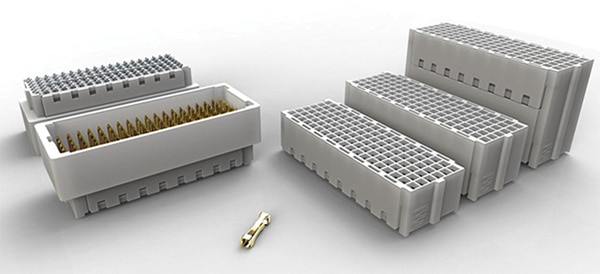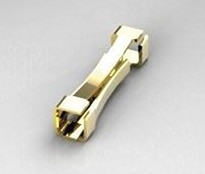Mezalok Connectors High-Reliability XMC Mezzanine Connector
2016-03-30
Introduction
Mezzanine boards give additional flexibility for systems by providing for expanded functionality and modularity to a PC board. They allow existing boards to be re-configured, upgraded, or customized by the addition of the mezzanine card. Typical applications include application- specific high-speed input/output (I/O) protocols, graphics, memory, and digital-signal processing. Mezzanine boards are widely used in the telecommunications, industrial, and military/aerospace markets.
To support high data rates, serial switched architectures are finding widespread use. Serial data streams more easily support high data rates and allow lower cost PC boards since issues such as differential skew in parallel data paths are eliminated. Two of the fastest growing architectures— VITA 41 VXS and VITA 46 VPX—are serial, switched.
The switched mezzanine card (XMC) is a serial, switched fabric supporting high-speed protocols. Defined in VITA 42, XMC supports serial and parallel RapidIO, PCI Express, HyperTransport, and 10 Gb/s Ethernet. XMC is an extension of the pervasive PCI mezzanine card (PMC) standard. It adds additional high-speed interconnects to the existing PMC standard. XMC maintains compatibility with PMC form factors, stacking heights, and other specifications.
Background
The original VITA 42 XMC connectors were not designed with military applications as a central design goal. Indeed, users have experienced reliability issues in the demanding environment of military applications, where high levels of vibration and thermal cycling can stress a connector’s performance and decrease signal integrity. Users have reported cracked solder joints from thermal cycling and damaged contacts from stubbing during mating.
As a result of these issues and other feedback from customers, TE Connectivity (TE) engineering began a development program to design a new high-reliability XMC connector to meet the demanding requirements of military needs. Goals for the development program included:
- Uniform solderball and contact retention features of mated connectors to improve reliability
- High-reliability socket contact design based on MIL-C-55302 Mini-Box contact
- Improved thermal cycling stability—2000 or more thermal shock cycles
- Anti-stub design with protected lead-in
- Improved durability of 500 cycles minimum
- Footprint compatibility with existing XMC board layouts
The result is the Mezalok connector (Figure 1). The connector is the proposed solution to become a standards-based XMC choice under VITA 61.

Figure 1: Mezalok XMC connectors and socket contact.
Solderball: compliancy brings reliability
The Mezalok header and receptacle connectors attach to the boards by well-established ball-grid array technology. The solder tail design of Mezalok connectors uses a proven compliant design to provide robust, uniform solder joints. The compliancy is important for two reasons.
First, it accommodates variations in the board-to-connector coplanarity. Ideally, the solder balls would meet the PC board pads along a perfect plane. In reality, small variations exist. With a noncompliant contact design, lack of coplanarity can result in nonuniform solder joints—some stronger or weaker than others. Compliancy helps ensure uniform reliable joints.
Second, compliancy is much more forgiving of thermal cycling, which can lead to cracking of solder joints if some flexibility is not achieved. Since different parts of the connection—PC board, solder joint, and connector housing and contacts—have different coefficients of thermal expansion, a rigid design can lead to failure of the joint. In a military environment, with higher levels of vibration, even small cracks can quickly lead to joint failure.
The BGAs also permit use of well-established solder processing.
High-reliability contacts for demanding environments
The contact design selected for the Mezalok connector was based on the MIL-C-55302 Mini-Box contact. This contact has years of proven performance in military environments. The design uses four spring members to provide contact on all four sides of the pin, a configuration that works well in high-vibration applications. The redundant four points of contact ensure a low-resistance, reliable connection under trying application circumstances.
The shape of the Mini-Box springs, with their gentle radii, also allows lower insertion forces while maintaining high normal forces when mated. The lower insertion force, in turn, means easier engagements and disengagement of connectors, higher durability, and less chance of damage.

Figure 2: The Mini-Box receptacle design, with redundant spring force on all four sides, has years of proven field use for high-speed application in harsh military environments.
Improved thermal stability
As mentioned, thermal cycling can be a major failure mechanism in connectors used in military applications. The compliant design of the solder balls accommodates thermal expansion and contraction. In addition, housings are made of liquid crystal polymer (LCP), which has a low coefficient of thermal expansion and withstands soldering temperatures, including the higher temperatures associated with lead-free solders. Overall, the new design presents a thermally stable connector that withstands thermal extremes well. The connector has been tested to 2000 thermal shock cycles with no failures.
Anti-stub design
Stubbing occurs when the pin contact does not mate properly with the receptacle. In severe stubbing, the pin can even miss the socket entirely, being pushed into the housing on the outside of the socket. Stubbing can result in damaged contacts, high resistance, and lower cycle life. The design of the Mezalok connector eliminates stubbing through four main features (Figure 3).

Figure 3: A pin lead-in, closed contact end, and housing overlap all combine to protect the connector system from contact stubbing.
First, the Mini-Box contact is boxed at the end so that there are no exposed spring ends to become deformed or present a stubbing surface.
Second, the receptacle housing provides generous chamfered lead-ins to the Mini-Box contacts. The ends of the contacts are protected by the housing overhanging and protecting the ends of the receptacle.
Third, the pin connector is fully shrouded to reduce the possibility of pins being bent. Fourth, the tip of the pin is tapered to help direct entry into the receptacle.
Improved durability
The durability target for connectors used in military and aerospace applications is 500 mating cycles. Existing VITA 42 XMC connectors are only specified for 100 mating cycles. The new design meets military durability requirements. Redundant four-sided configuration of the Mini-Box contacts means less wear and tear on the contacts since each spring can have a lower individual normal force.
Mezalok contacts are a high-performance copper alloy selectively plated with 50 microinches of gold in the mating areas (with 30 microinches as an option). Gold plating, of course, ensures a low-resistance mating without corrosion or films developing over time.
XMC compatibility
Mezalok connectors use the same PC board footprint as VITA 42 connectors. While the two connectors are not intermateable, the Mezalok connector is a drop-in replacement without requiring board redesign. Like VITA 42 connectors, the Mezalok connector is configured as a 114- position connector with contacts arranged on 0.050-inch centers in a 6 x 19 grid. A 60-position (6 x 10) connector is also available for special applications.
The new connector supports both standard XMC stacking heights 10 and 12 mm and, by customer request, a new height of 18 mm. For the carrier (daughterboard) side, the pin header is a fixed height of 4 mm. Receptacle connectors on the mezzanine side are available in heights of 6, 8, and 14 mm.
Solder balls are available either as tin-lead or RoHS-compliant SAC 405 lead-free materials.
| Feature | VITA 61* Mezalok Connector | VITA 42 XMC Connector |
| Thermal Cycling (tin-lead) -55°Cto +125°C | 2000 cycles | ? |
| Data Rate | 5 Gb/s | 3.125Gb/s |
| Durability (Mating Cycles) | 500 | 100 |
| Socket Pedigree | M55302 | Commercial |
| Protected Socket End Face (no stub) | Yes | No |
| Exposed Header Contacts When Mated | No | Yes |
| Contact Interface Lead-in (blind mate) | Yes | No |
| Purposely Designed for Mil/Aero Environ | Yes | No |
| Dedicated Design for 12 mm Stack | Yes | No |
|
*Under evaluation by VITA 61 committee. |
||
Figure 4: Comparison of high-reliability Mezalok connector with the more commercially oriented VITA 42 XMC connector.
Performance
Since the Mezalok connector is designed for high-speed applications, signal integrity analysis was performed to characterize the electrical performance of the connector. The XMC standard uses serial communications, most often with differential pairs to reduce noise. Figure 5 shows the differential impedance for the 12 mm connector pairs measured at a 50 ps risetime using a standard VITA 42 XMC footprint. The results show a high degree of uniformity between pairs.

Figure 5: Measured differential impedance for 12 mm connector pair.
The connector is also designed to give designers flexible choices in meeting design goals. Among the options available are:
- Stacking heights: 10, 12, and 18 mm
- Gold plating: 30 or 50 microinches
- Solder balls: tin-lead or lead-free (SAC 405)
- Number of contacts: XMC-standard 114 positions or “half-size” 60 positions
Conclusion: ready to take flight
The design enhancements that the Mezalok connector offers for XMC applications mean that XMC is ready for primetime in military and aerospace applications. The combination of high data rates and a robust design to withstand vibration, shock, and extreme temperatures gives designers of VXS and VPX systems a high-reliability interconnection system. The connector capitalizes on existing technology that is well understood and field proven. Mini-Box contacts have been in use for decades and today support high-speed backplane and now mezzanine interconnections. Likewise, the BGA solder technology, with its compliant design, has been widely used in connectors and high-pin-count sockets with exceptional reliability.
免责声明:各个作者和/或论坛参与者在本网站发表的观点、看法和意见不代表 DigiKey 的观点、看法和意见,也不代表 DigiKey 官方政策。






 中国
中国